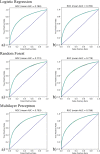Early prediction of acute kidney injury following ICU admission using a multivariate panel of physiological measurements
- PMID: 30700291
- PMCID: PMC6354330
- DOI: 10.1186/s12911-019-0733-z
Early prediction of acute kidney injury following ICU admission using a multivariate panel of physiological measurements
Abstract
Background: The development of acute kidney injury (AKI) during an intensive care unit (ICU) admission is associated with increased morbidity and mortality.
Methods: Our objective was to develop and validate a data driven multivariable clinical predictive model for early detection of AKI among a large cohort of adult critical care patients. We utilized data form the Medical Information Mart for Intensive Care III (MIMIC-III) for all patients who had a creatinine measured for 3 days following ICU admission and excluded patients with pre-existing condition of Chronic Kidney Disease and Acute Kidney Injury on admission. Data extracted included patient age, gender, ethnicity, creatinine, other vital signs and lab values during the first day of ICU admission, whether the patient was mechanically ventilated during the first day of ICU admission, and the hourly rate of urine output during the first day of ICU admission.
Results: Utilizing the demographics, the clinical data and the laboratory test measurements from Day 1 of ICU admission, we accurately predicted max serum creatinine level during Day 2 and Day 3 with a root mean square error of 0.224 mg/dL. We demonstrated that using machine learning models (multivariate logistic regression, random forest and artificial neural networks) with demographics and physiologic features can predict AKI onset as defined by the current clinical guideline with a competitive AUC (mean AUC 0.783 by our all-feature, logistic-regression model), while previous models aimed at more specific patient cohorts.
Conclusions: Experimental results suggest that our model has the potential to assist clinicians in identifying patients at greater risk of new onset of AKI in critical care setting. Prospective trials with independent model training and external validation cohorts are needed to further evaluate the clinical utility of this approach and potentially instituting interventions to decrease the likelihood of developing AKI.
Keywords: Acute kidney injury; Artificial neural networks; Intensive care unit; Multivariate logistic regression; Physiological measurements; Predictive modeling; Random forest.
Conflict of interest statement
Ethics approval and consent to participate
Not applicable
Consent for publication
Not applicable
Competing interests
The authors declare that they have no competing interests.
Publisher’s Note
Springer Nature remains neutral with regard to jurisdictional claims in published maps and institutional affiliations.
Figures


Similar articles
-
Explainable Machine Learning Model for Predicting Persistent Sepsis-Associated Acute Kidney Injury: Development and Validation Study.J Med Internet Res. 2025 Apr 28;27:e62932. doi: 10.2196/62932. J Med Internet Res. 2025. PMID: 40200699 Free PMC article.
-
A risk prediction score for acute kidney injury in the intensive care unit.Nephrol Dial Transplant. 2017 May 1;32(5):814-822. doi: 10.1093/ndt/gfx026. Nephrol Dial Transplant. 2017. PMID: 28402551
-
Neutrophil gelatinase-associated lipocalin at ICU admission predicts for acute kidney injury in adult patients.Am J Respir Crit Care Med. 2011 Apr 1;183(7):907-14. doi: 10.1164/rccm.200908-1214OC. Epub 2010 Oct 8. Am J Respir Crit Care Med. 2011. PMID: 20935115
-
Development and Comparative Analysis of an Early Prediction Model for Acute Kidney Injury within 72-Hours Post-ICU Admission Using Evidence from the MIMIC-III Database.Discov Med. 2023 Aug;35(177):623-631. doi: 10.24976/Discov.Med.202335177.61. Discov Med. 2023. PMID: 37553314
-
Incidence, timing and outcome of AKI in critically ill patients varies with the definition used and the addition of urine output criteria.BMC Nephrol. 2017 Feb 20;18(1):70. doi: 10.1186/s12882-017-0487-8. BMC Nephrol. 2017. PMID: 28219327 Free PMC article. Review.
Cited by
-
A recurrent machine learning model predicts intracranial hypertension in neurointensive care patients.Brain. 2022 Aug 27;145(8):2910-2919. doi: 10.1093/brain/awab453. Brain. 2022. PMID: 35139181 Free PMC article.
-
Validation of a cancer population derived AKI machine learning algorithm in a general critical care scenario.Clin Transl Oncol. 2025 Mar 26. doi: 10.1007/s12094-025-03906-0. Online ahead of print. Clin Transl Oncol. 2025. PMID: 40140139
-
Development of a neural network model for early detection of creatinine change in critically Ill children.Front Pediatr. 2025 Apr 4;13:1549836. doi: 10.3389/fped.2025.1549836. eCollection 2025. Front Pediatr. 2025. PMID: 40256396 Free PMC article.
-
A deep-learning model to continuously predict severe acute kidney injury based on urine output changes in critically ill patients.J Nephrol. 2021 Dec;34(6):1875-1886. doi: 10.1007/s40620-021-01046-6. Epub 2021 Apr 26. J Nephrol. 2021. PMID: 33900581 Free PMC article.
-
Distinct Subtypes of Hepatorenal Syndrome and Associated Outcomes as Identified by Machine Learning Consensus Clustering.Diseases. 2023 Jan 27;11(1):18. doi: 10.3390/diseases11010018. Diseases. 2023. PMID: 36810532 Free PMC article.
References
Publication types
MeSH terms
Grants and funding
LinkOut - more resources
Full Text Sources
Other Literature Sources
Medical
Miscellaneous

